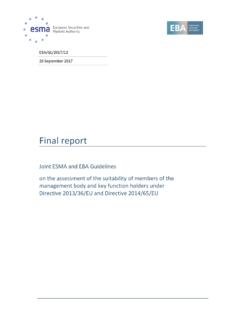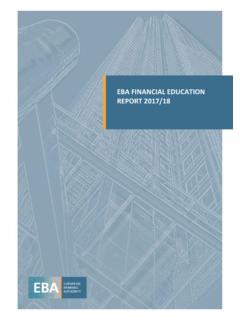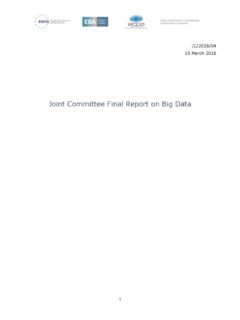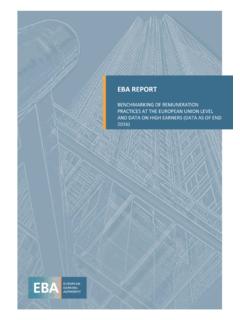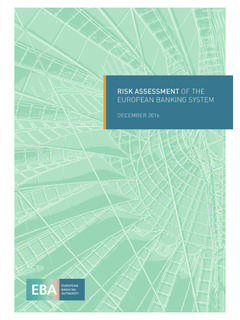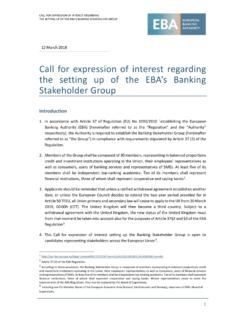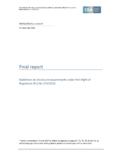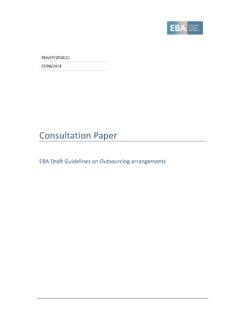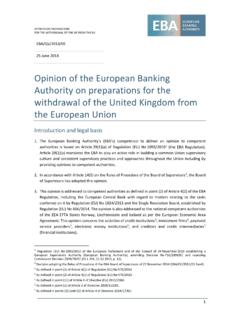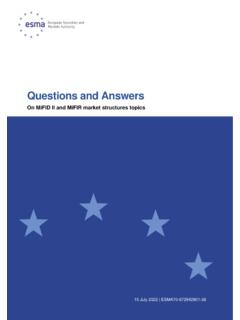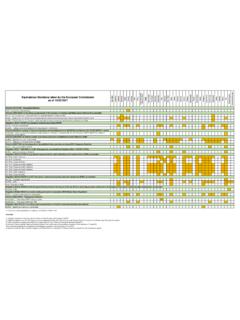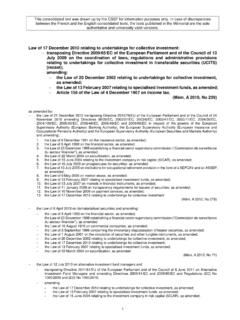Transcription of Final report on
1 Final report ON GUIDELINES ON INTERNAL GOVERNANCE UNDER directive (EU) 2019/2034 EBA/GL/2021/14 22 November 2021 Final report on Guidelines on internal governance under directive (EU) 2019/2034 Final report ON GUIDELINES ON INTERNAL GOVERNANCE UNDER directive (EU) 2019/2034 Contents Executive summary 3 Background and rationale 4 and reporting obligations12 Status of these guidelines 12 Reporting requirements 12 matter, scope and definitions13 Subject matter 13 Addressees 13 Scope of application 13 Definitions 14 Date of application 16 Title I proportionality 17 Title II role and composition of the management body and committees 19 1 Role and responsibilities of the management body 19 2 Management function of the management body 22 3 Supervisory function of the management body 22 4 Role of the chair of the management body 23 5 Committees of the management body in its supervisory function 24 Setting up committees 24 Composition of committees 25 Committees processes 26 Role of the risk committee 26 Title III governance framework 27 6 Organisational framework and structure 27 Organisational framework 28 Know your structure 28 Complex structures and non-standard or non-transparent activities 29 7 Organisational framework in a
2 Group context 31 Title IV risk culture and business conduct 33 8 Risk culture 33 9 Corporate values and code of conduct 34 10 Conflict of interest policy at firm level 35 Final report ON GUIDELINES ON INTERNAL GOVERNANCE UNDER directive (EU) 2019/2034 2 11 Conflicts of interest policy for staff 36 Conflicts of interest policy in the context of loans and other transactions with members of the management body and their related parties 38 Documentation of loans to members of the management body and their related parties and additional information 39 12 Internal alert procedures 40 13 Reporting of breaches to competent authorities 42 Title V internal control framework and mechanisms 42 14 Internal control framework 42 15 Implementing an internal control framework 43 16 Risk management framework 44 17 Internal control functions 46 Heads of the internal control functions 47 Independence of internal control functions 47 Resources of internal control functions 47 18 Risk management function 48 RMF s role in risk strategy and decisions 49 RMF s role in material
3 Changes 49 RMF s role in identifying, measuring, assessing, managing, mitigating, monitoring and reporting on risks 49 RMF s role in limits 50 Head of the risk management function 50 19 Compliance function 51 20 Internal audit function 52 Title VI business continuity management 54 Title VII transparency 55 Annex I aspects to take into account when developing an internal governance policy 57 documents59 Draft cost-benefit analysis/impact assessment 59 Feedback on the public consultation and opinion of the Banking Stakeholder Group 63 Final report ON GUIDELINES ON INTERNAL GOVERNANCE UNDER directive (EU) 2019/2034 3 Executive summary For several years now, internal governance issues have received increased attention from various international bodies. Their main aim has been to correct financial institutions weak or superficial internal governance practices, including compliance with the framework to prevent money laundering and terrorist financing, as the reinforcement of internal governance arrangements is a critical issue for the sustainable growth of market-based financing.
4 Sound internal governance arrangements are fundamental if investment firms are to operate well as part of the financial system. directive (EU) 2019/2034 sets out governance requirements for investment firms and, in particular, stresses the responsibility of the management body to ensure sound governance arrangements, the importance of a strong supervisory function that challenges management s decision-making and the need to establish and implement a sound risk strategy, risk appetite, risk culture and risk management framework. To further harmonise investment firms internal governance arrangements, processes and mechanisms within the EU, in line with the requirements introduced by directive (EU) 2019/2034, the European Banking Authority (EBA) is mandated by Article 26(4) of directive (EU) 2019/2034 to develop guidelines in this area.
5 The guidelines apply to investment firms as defined in Article 4(1)(1) of directive (EU) 2014/65 that do not meet all of the conditions for qualifying as small and non-interconnected investment firms under Article 12(1) of Regulation (EU) 2019/2033. These requirements apply regardless of the investment firms governance structures (unitary board, dual board or other structure). However, the guidelines do not advocate or prefer any specific structure. The terms management body in its management function and management body in its supervisory function should be interpreted in accordance with the applicable law within each Member State. The guidelines complete the various governance provisions in directive (EU) 2019/2034, taking into account the principle of proportionality, by specifying the tasks, responsibilities and functioning of the management body, and the organisation of investment firms, including the need to create transparent structures that allow for the supervision of all their activities.
6 The guidelines also specify in more detail the requirements under directive (EU) 2019/2034 and aim to ensure the sound management of all risks. Risks need to be managed across all three lines of defence. While the business needs to manage its risks, the guidelines stress the responsibilities of the second line of defence (the independent risk management and compliance function) and also the third line of defence (the internal audit function). The guidelines are consistent with the guidelines on internal governance for credit institutions and with international standards and, in particular, set out provisions that aim to foster a sound risk culture to be implemented by the management body, strengthening the management body s oversight of the investment firm s activities and implementing a sound risk management framework.
7 Final report ON GUIDELINES ON INTERNAL GOVERNANCE UNDER DIRECTVIE (EU) 2019/2034 4 Background and rationale in the reliability of the financial system is crucial for its proper functioning and aprerequisite if it is to contribute to the economy as a whole. Consequently, effective internalgovernance arrangements are fundamental to the sustainable growth of recent years, internal governance issues have received increased attention from variousinternational bodies1. Their main aim has been to correct financial institutions weak orsuperficial internal governance practices, as identified during the financial crisis and duringongoing supervision by competent authorities. In addition, there has recently been a greaterfocus on conduct-related shortcomings and activities in offshore financial centres, and in thearea of money laundering and terrorist some cases, the absence of effective checks and balances within financial institutionsresulted in a lack of effective oversight of management decision-making, which led to short-term and excessively risky management strategies.
8 Weak oversight by the management bodyin its supervisory function has been identified as a contributing factor. The management body,both in its management function and, in particular, in its supervisory function, might not haveunderstood the complexity of the business and the risks involved. Consequently, these bodiesfailed to identify and constrain excessive risk-taking in an effective governance frameworks, including internal control mechanisms and riskmanagement, were often not sufficiently integrated within financial institutions or functions were not regarded as a high priority, which impacted the stability of marketsas a result. In many investment firms there was a lack of a uniform risk methodology andterminology, which meant that there was no holistic view of all risks. Internal control functionsoften lacked appropriate resources, status and/or , sound internal governance practices helped some financial institutions to managethe financial crisis significantly better than others.
9 These practices included the setting of anappropriate risk strategy and appropriate risk appetite levels, a holistic risk managementframework and effective reporting lines to the management this backdrop, there is a clear need to address the potentially detrimental effects ofpoorly designed internal governance arrangements on the sound management of risk, toensure effective oversight by the management body, in particular in its supervisory function,to promote a sound risk culture at all levels of investment firms and to enable competentauthorities to supervise and monitor the adequacy of internal governance IOSCO/OECD Final report ON GUIDELINES ON INTERNAL GOVERNANCE UNDER DIRECTVIE (EU) 2019/2034 5 Legal basis further harmonise investment firms internal governance arrangements, processes andmechanisms within the EU, the EBA, in cooperation with the ESMA, is mandated underArticle 26(4) of directive (EU) 2019/2034 to develop guidelines in this 26 (1) of directive (EU) 2019/2034 requires investment firms to have robustgovernance arrangements, including a clear organisational structure with well-defined,transparent and consistent lines of 28 of directive (EU) 2019/2034 sets out requirements for the involvement of themanagement body in risk management and the setting up of a risk committee for accordance with Article 25 of directive (EU) 2019/2034 and Article 7 of Regulation (EU)2019/2033, these guidelines apply on an individual and consolidated basis.
10 For this purpose,parent undertakings and subsidiaries subject to directive (EU) 2019/2034 must ensure thatinternal governance arrangements, processes and mechanisms in their subsidiaries areconsistent and well integrated and that the governance arrangements on a consolidated basisare robust. In particular, it should be ensured that parent undertakings and subsidiariessubject to this directive implement such arrangements, processes and mechanisms in theirsubsidiaries that are not subject to this directive , including those established in third countries including offshore financial guidelines should be read, taking into account and without prejudice to Articles 9, 16, 23and 24 of directive (EU) 2014/65, the Commission Delegated Regulation (EU) 2017/5652 andthe Commission Delegated directive (EU) No 2017/5933, in conjunction with the EBAguidelines on sound remuneration policies for investment firms, the joint EBA and ESMA guidelines on the assessment of the suitability of members of the management body and keyfunction holders, the EBA guidelines on the supervisory review and evaluation process (SREP),the ESMA guidelines on certain aspects of the MiFID II compliance function requirements, theESMA guidelines on product governance and the Regulatory Technical Standards and objective of the guidelines governance includes all standards and principles concerned with setting aninvestment firm s objectives, strategies and risk management framework; how its business isorganised; how responsibilities and authority are defined and clearly allocated.
